Chapter 3: Cruising up and Down the Nile
Introduction: On our trip to Egypt we flew from Cairo to Aswan were we boarded the River Boat M/S Anuket for a trip down the Nile. Along the river we stoped at several sites to see the ancient Egyptian tombs and temples. In an attempt to have some order to this report of my journey I have chosen to place all the river scenes on this page. You will find links to it as you go through the rest oof my pages. Have an enjoyable time as you join me up and down the Nile.

Aswan to Kom Ombo
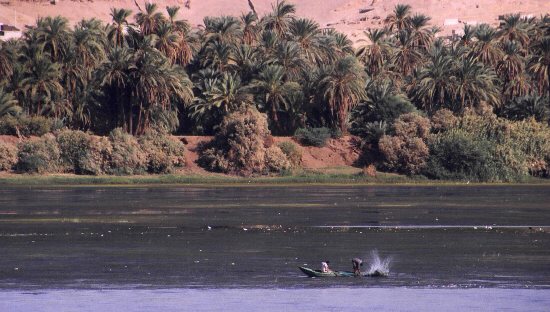 As we left Awan I was tired, and desperately wanted to take a nap, but how could I sleep when we started cruising down the Nile? |
The desert almost comes down to the water as fishermen try to stir up the fish by slapping the water with a board. |
| Farmers cool themselves from the hot afternoon sun by sit sitting under the shade of palms trees growing in silt laid down by the Nile after several millenium of the annual floods. | 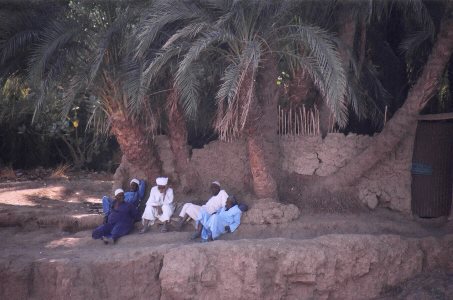 |
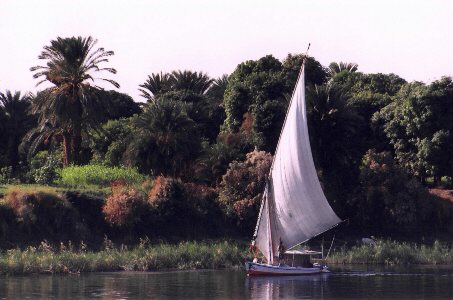 |
A felucca sails quietly up river in the gentle breeze of a warm afternoon. |
| Two fishermen in their brightly painted row boat wave as we sail by. Note the oars - nothing more than a 1" x 6" flat board. | 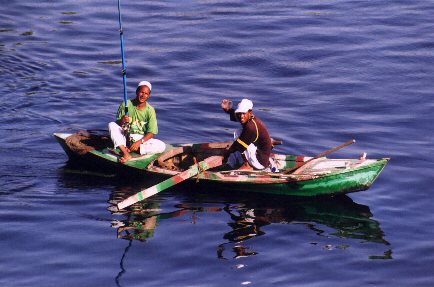 |
Edfu to Luxor
December 18, 2003
We left Edfu and the temple of Horus behind us about noon and again sailed down the Nile. The river isn't very wide and has no channel markers to tell the Captain where to go. The channel is learned by years of experience, starting when he is just 10 years old while accompanying his father who was also a river pilot. The lore of the river is handed down generation after generation.
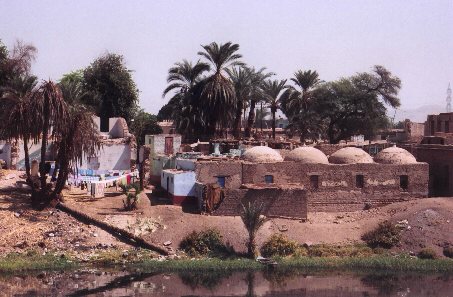
Although the river appears to be straight the actual channel winds from side to side. On occasion we were not more than 50 feet from shore which allowed me to take some good photos with my 300mm zoom lens. Here is a small farming village right up to the shore. The home are made of mud brick as they have been made for thousands of years out of the silt brought down by the annual floods. I asked our guide in Israel why the homes had domes on the roofs. His reply was that they were just design. In Egypt I asked Maged the same question and he said they were designed to keep the home cooler. Unlike a flat room the dome presented less area to the rays of the hot sun. Also, the dome allowed the roof to be higher so the heat in the house could rise and make the living quarters cooler. That's the difference in guides.
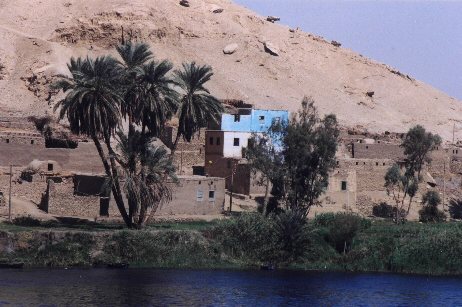
![]()

Everyone has heard of the annual flooding of the Nile and how the land was rejuvenated yearly with new silt and water to grow crops. The annual flooding no longer takes place because of the High Aswan dam. The land now has to be manually fertilized but now the water flow is constant so rather than getting two crops a year the farmer is able to grow five crops because the weather is so mild. There are miles and miles of canals branching off the Nile that takes the water far inland.
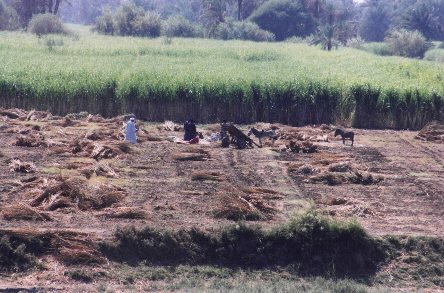
Yet, the farm fields are small, almost garden plot size, and all the work is done by hand. Here you see a crop being harvested. The donkeys stand waiting to be loaded or hitched to the cart.
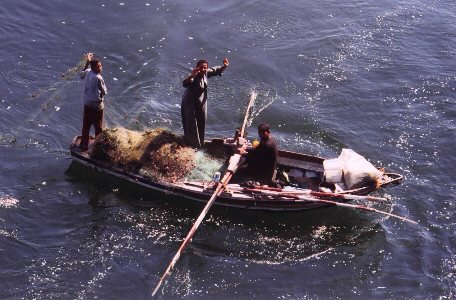
Fishing in the Nile is also a local farming business. Here three men, or perhaps boys, are pulling in their net to see what they have caught.
![]()

After spending the day cruising down the Nile and heading for Luxor we had a program of Egyptian Folk Lore. The passengers were the players. So we had belly dancers, a city elder with his 6 wives (only four could make it to the pageant; one had a headache and another was in the hospital giving birth); a couple of sailors from Alexandria, and a tourist being hounded by trinket salesman.
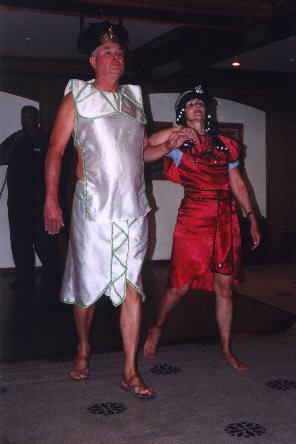 |
But the hit of the evening was when the Pharaoh and his favorite wife made a surprise visit. |
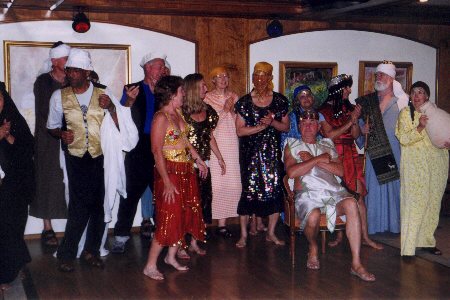 |
There is always a grand finale when all the actors come out to a thunderous applause of the audience. Three or four curtain calls if I recall it correctly. |
Cruising Down the Nile from Luxor to Dendara
The next morning we woke up with our boat tied up to a dock in Luxor
where we visited the Great Temple of Karnak.
![]()

Jan 5, 2004
For a bajillion years the Nile flooded the valley and deposited it silt along the shores. The silt provided bricks for their homes and soil for their crops. The Nile provided the water. You don't need anything more. The photo above may be one entire family complex of grandparents, parents, uncles, aunts, cousins, brothers and sisters, etc. As the family grows the houses get taller; no urban sprawl allowed here.
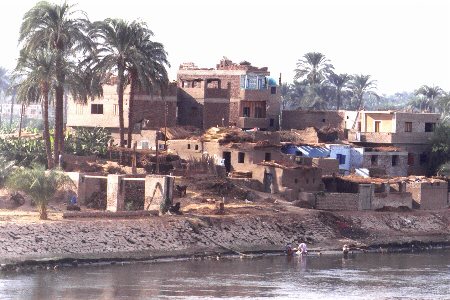
As we left Luxor and sailed down the Nile on Monday afternoon I was living a dream. Although the river was pretty straight the captain followed the unmarked channel and we zigged zagged from bank to bank. Sometimes we were within 100 feet, or less from shore.
| Monday is the same everywhere - laundry day. We were told the homes all had running water but washing the laundry in the Nile is a family/community social thing. |  |
![]()
(Jan 6, 2004)
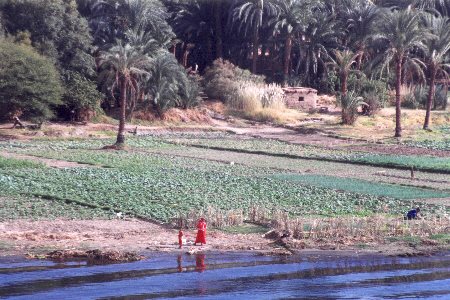
Water which used to be lifted by man or donkey-power out of the river and into small irrigation channels is now pumped by large gasoline or electrical pumps. It was not uncommon for the quiet of the afternoon to be disturbed by the sound of a gas engine pumping water from the river to the gardens. It seemed that the people lived close to the Nile (see previous pictures) and the farms are really just large garden plots. Since there appear to be few tractors and combines and all the farm work is done by hand or small animals this is about all that can be handled. In the delta, and other areas where the river basin is wider, there are larger farms.
| For the most part what we saw adjacent to the Nile were small individual farming plots being worked by hand. If you look carefully you can see standing water in one of the fields. This means it has been flooded and is being prepared for a new crop to be planted. | 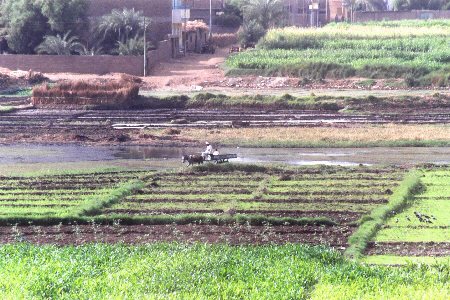 |
Once again we sailed overnight and the next morning we were rested and prepaed to explore Dendara.
![]()
(Jan 12, 2004)
Cruising up the Nile from Dendera to Luxor.
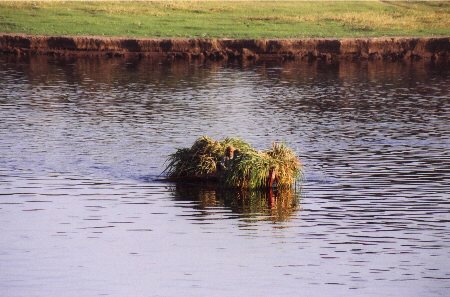
Many times I saw small islands in the middle of
the river where cattle were grazing. I asked our guide how someone gets to
own an island. He said that no one owns the islands because during the
floods the islands are under water and when the water recedes the island may
be gone. So anyone can use it but I imagine there are
some sort of rules of who gets first priority to take his cattle over.
Maybe they need some good lawyers.
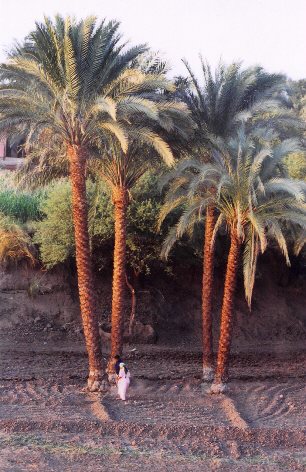 |
No tillable land is ignored. Here you can see how the land right up to the palm tree is prepared for irrigation. Notice the high river bank behind the trees - silt from the Nile built up over hundreds of years. |
![]()

Once again we sailed all afternoon and all night, this time fighting the current of the Nile as we headed south. When we awoke our boat was tied to the shore in Luxor and we headed off to explore West Thebes where lies the Valley of the Kings and Queens
![]()
Jump Station
Go to The Egyption Museum of Cairo - Under Construcion
Go to The Religious Faiths - Under Construction Go to Street Scenes of Cairo - Under Construction Go to Who are the Gods? - Under Construction. Go to Chapter 9: The Khan el-Khali Bazaar - Under Construction Go to Chapter 8: The Pyramids - Under Construction Go to Chapter 7: East Thebes and the Temple of Luxor - Under Construction Return to Chapter 6: The Pyramids.Return to Chapter 5: Karnak Temple at Luxor and the Temple of Hathor at Dendera.
>Return to Chapter 4: Kom Ombo, Edfu, Karnak and Dendera.
Return to Chapter 3: Cruising Down the Nile.
Return to Chapter 2: Abu Simbel and Aswan.
Return to Chapter 1: Introduction to Egypt.
Read about my version of The Gods of Egypt and Diagram of Temples.
Return to Belli's Home Page
![]()
For more information about our travels write to![]() Belli.
Belli.
